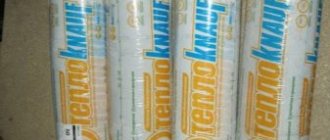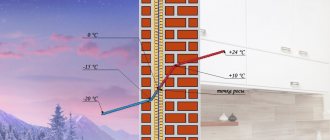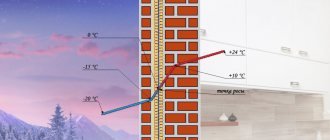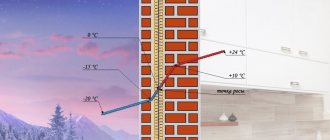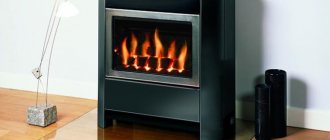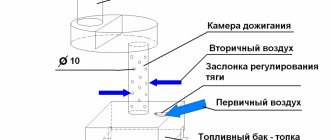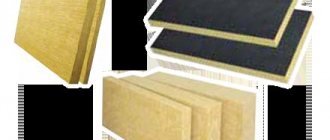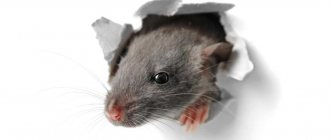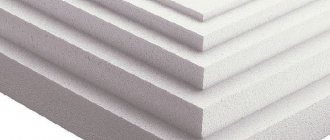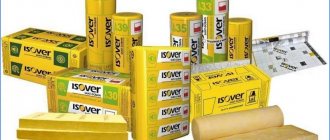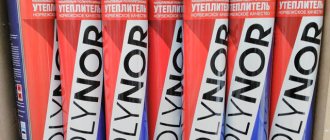Isorok insulation: reviews, characteristics.
High energy efficiency indicators of buildings against the backdrop of constant rise in prices and noticeable savings in energy resources are the need of our time. There are a huge number of methods for this, and one of them is insulation. The choice of material that can be called high-quality plays an important role in this case. Thanks to new production lines, it has become possible to produce high-quality materials that are used for insulation of building and enclosing structures. In this article we will talk about Isorok insulation and reviews about it. All products manufactured under the Isorok brand were noted only in a positive way, since they meet all international quality requirements and have become the leader in thermal insulation materials. The excellent performance properties of this insulation, combined with a reasonable price, have made it popular in the construction of new buildings and the renovation of old ones, which helps improve energy efficiency.
Features of mineral wool insulation
Rockwool mineral wool is classified as an environmentally friendly material, for the manufacture of which durable rocks of basalt and gabbro were used without the inclusion of metallurgical waste. The final product has high thermal insulation characteristics and excellent performance properties.
To obtain basalt wool slabs, rocks are melted at elevated temperatures and then drawn into fibers, similar to how the material is formed in natural conditions.
Unlike mineral wool-based insulation of the previous generation, when the fibers were laid in strict order in rows, Rockwool basalt wool slabs are created with fibers laid in a chaotic manner, which favorably reflects the technical characteristics of the material, reducing its specific gravity.
Analysis of the characteristics of the insulation allows us to note its ability to cope with high temperatures - Rockwool slabs can withstand temperatures over 1000 degrees Celsius. Insulation is used both in domestic construction and for thermal insulation of industrial facilities, where compliance of the characteristics with fire safety requirements is fundamentally important.
Materials based on Rockwool mineral wool are universal and practical, helping to create and maintain a comfortable microclimate in the room, regardless of the time of year.
We consider the key advantages
Isoroc insulation is recognized in all areas of construction (from low-rise private to industrial).
This is due to its most important advantages:
- Long operational period. If you follow all installation rules and standards, the insulation will last for several decades (under normal conditions). This is a key property of the material, which predetermined its popularity.
- Ecological cleanliness. Isoroc mineral wool, unlike many of its counterparts, does not emit harmful carcinogens and is safe to use. This is achieved due to the fact that only natural materials are used in its production.
- Versatility in use. There are many varieties (they will be discussed below) to solve a variety of problems.
- Gives floors additional sound insulation. Using isoroc, you do not need to lay a sound-absorbing substrate. This saves time and money.
- Low weight, which greatly facilitates the installation procedure. In addition, this eliminates the need to create a heavy-duty frame. The mats can simply be secured with glue or staples (if we are talking about a wooden structure).
- Fire safety - the material does not burn or smolder. This is one of the few representatives of the basalt wool family that can boast of these. It's all about special impregnations that prevent the combustion process.
- Elasticity.
Product line
The density of Isoflor allows it to be laid under a concrete screed or decorative floor.
The Isoroc line of wall insulation contains several subtypes, focused on the characteristics of the surfaces being protected and various areas of application. It includes the following items:
- Izolight-L;
- Isovent;
- Isofrol;
- Izoruf in packs;
- Isorok in slabs (in cylindrical shapes).
Samples of Izolight-Lux products have a density of 60 kg/cubic meter. meter and are used to insulate surfaces of various orientations. At the same time, large loads and deformation stresses in the layers of products of this type are unacceptable. The next model in the series, Isovent-L, has a significantly higher density (up to 90 kg/cubic meter) and is used for arranging ventilation for building facades.
For the Isoflor modification, the density indicated by the manufacturer is close to 140 kg/cubic meter. m. This insulation is used as an intermediate link in three-layer reinforced concrete structures. Can be used in sandwich panels. For thermal insulation of roofs and concrete floors, another type of insulation material called Izoruf is used. It is produced with the markings H, B or NL, and its average density is 110 kg/cubic meter. meter. Blanks of this material or mats without a piercing shell are marked as “MP”, and if it is present – “MP (ST)”.
Isorok insulation in slabs has two modifications with a material density of 75 and 100 kg/cubic. per meter respectively. They are optimally suited for protecting any horizontal surfaces, but do not allow the load to exceed the maximum level. Isorok Cylinders, marked CF, are considered as a separate category of heat insulators. Various samples of these products differ in the diameter of the cylindrical blanks (ranging from 18-273 mm) and are used for insulating cold water and hot water pipes.
Plates
This category of insulation includes the largest range of products depending on the application.
Isolite – Lux and L
They are used for facade insulation and can be installed both vertically and in an inclined position. They are not designed for external loads - only a waterproofing layer can be installed on their surface.
Isovent L
Material with a higher density. It is used for ventilated facades and as a middle layer when forming a multi-level insulation system.
Isoflor – S and K
The optimal solution for creating a reliable insulating layer in reinforced concrete and concrete structures. Installation on a cement screed with subsequent external loading is possible.
Izoruf – V (upper), N (lower) and NL (lower lung)
The integrated use of these insulating boards will allow you to create the most efficient sandwich structure. The high density of the top coating retains its shape and serves not only as a temperature barrier, but also as a protective layer. Plates for the lower layers have good energy-saving characteristics.
Information about the manufacturer Isorok
Izorok products are manufactured in compliance with European standards.
The date of appearance of the Russian brand “Izorok” is considered to be 2000, when a large association was created on the basis of the Tambov Mineral Insulation Plant. The further development of this production was supported by investments coming from a number of foreign companies.
Over time, Isorok mineral wool has become a very popular product, in demand in most areas of construction technology.
To expand the volume of mineral wool production, the association needed:
- significantly expand its production areas;
- acquire modern equipment that allows you to automate the work process;
- master new technologies for waste-free production of insulation products.
Thermal insulation Isorok is made on the basis of the finest fibers from a melt of mineral rocks, the individual components of which are held together by a special binder. The need to comply with all the subtleties of the technological chain stimulated the concern's engineers to constantly improve this process. Today it belongs to the undisputed leaders of the Russian market of insulation materials.
Mineral wool Isorok characteristics and advantages of use
Developed on the basis of the latest global innovative achievements, the insulation is several times superior to similar materials.
Isoroc thermal insulation has the following advantages:
- low thermal conductivity;
- high fire resistance;
- resistance to chemical compounds;
- strength during deformation and peeling of layers;
- soundproofing ability;
- vapor permeability, etc.
Isorok thermal insulation is used quite widely in civil and industrial construction. It is in demand where it is necessary to ensure fire safety, create sound insulation, and reduce the load on the foundation.
An environmentally friendly material, developed on the basis of natural materials, makes it possible to create favorable conditions indoors.
Membranes
The use of building thermal insulation materials when insulating the walls of buildings helps to increase the thermal resistance of the structure and reduces the fire hazard. In addition, with their use it is possible to enhance sound insulation, improve the characteristics of humidity conditions, and also reduce the load on the base of the building. Izorok materials have long gained great popularity among consumers.
In the construction of modern buildings, Isorok insulation materials are often used, but for ease of operation they require good protection. For this purpose, membrane materials with a specialized structure have been developed, thanks to which the products provide good thermal insulation characteristics. Membrane films are highly durable, resistant to rupture, and have excellent performance characteristics. Working with them is convenient and quite easy - this helps to significantly reduce the time required for production and installation work.
Membrane materials are used as decorative coatings that protect the thermal insulation structure. Available in the form of sheets rolled into a roll. This form provides more convenience in installation of products.
ISOROC FOIL-HI, -LHI materials are produced in the form of three-layer membranes with high vapor-permeable properties. They are used in construction work to create wind protection, water protection in insulated pitched roofs, and when constructing a ventilated facade. The product is highly resistant to ultraviolet rays. The use of the membrane is recommended in conjunction with insulating materials of the Isorok brand - in this way it is possible to significantly improve their heat-protective characteristics and increase the service life of the structure.
The ISOROC FOIL-VB variety is an active vapor barrier membrane that can protect the insulating layer from water vapor that escapes from the living space to the outside. Its use has many advantages. The use of this material, if the technology is followed correctly, will help the thermal insulation remain stable, and the service life of building structures increases several times.
Both retail and wholesale supplies of building materials are possible.
Application: protective and decorative coatings
Properties of mineral wool sandwich panels
Sandwich panels made of mineral wool are quite popular in construction. The thermal conductivity coefficient of this material is equal to the limit from 0.20 to 0.82 W/m*K. The degree of sound insulation of the material is 24 dB. The shear strength is 100 kPa, as is the compressive strength. The density of products can be equal to the limit from 105 to 125 kg/m3.
The structures do not require the use of special equipment for construction work; they are easily exposed to ultraviolet radiation and temperature changes. Sandwich panels do not rust, they are fire resistant and have excellent heat and sound insulation properties. If the panels are damaged, partial replacement is acceptable. Such structures do not create unnecessary load on the foundation. By visiting the store, you can choose any shade of the panels, which allows you to achieve an excellent aesthetic result.
Detailed review of the material
Next, the main nuances regarding isoroc insulation will be discussed in more detail.
All known varieties
There are several varieties of this insulation. They differ in many of their characteristics and areas of application.
It is important to choose the most suitable option to solve the problems. So, the varieties are as follows:
Isolite L (luxury). The density of the mats is 60 kg/cubic m. Such models are used primarily for soundproofing various surfaces. They are not able to withstand any loads. Isovent -L. It has a higher density - 90 kg/cu m. This variety can be used to create ventilated facades. Isoflor. Density - 140 kg/cu m. Main area of application: creating a middle layer in reinforced concrete structures. It is also used in the construction of sandwich structures (frame houses). Izoruf. Density - 110 kg/cube m
This material can be used for laying a heat-insulating layer on any horizontal (this is important) surfaces.
How to make a choice? Izoruf is perfect for floor insulation. Isoflor can be used for everything else (walls, ceilings and other floors). Well, for laying pipes in private houses, it is necessary to use only the CF variety, since other analogues will become unusable too quickly.
Analyzing technical characteristics
The varieties that differ from each other primarily in density were discussed above. However, the main parameters for all categories are approximately at the same level. Therefore, we can safely list them:
- Thermal conductivity coefficient: 0.06-0.07 W/(m*K). This is a key characteristic on which the effectiveness of insulation depends. It is worth noting that isoroc is second only to penoplex in this component.
- The water absorption rate is 5% (with the exception of CF brands, their coefficient is close to zero). In fact, this is a very serious value, which means that this group of materials is “afraid” of direct moisture.
- Tensile strength - 15 kPa.
- Compressive strength - 52 kPa.
Thermal conductivity coefficient of Ursa wool
The table of thermal conductivity and other qualities of the material quite often allows consumers to make the right choice. This is also true when it comes to Ursa mineral wool. If you need insulation for thermal insulation of the roof, floor and walls, then you can choose Ursa Geo M-11 with a thermal conductivity coefficient within 0.040 W/m*K. The slabs, presented in rolls and produced under the name URSA GEO, are intended for pitched roofs. The thermal conductivity coefficient in this case is 0.035 W/m*K.
To insulate floors, acoustic ceilings and ceilings, URSA GEO Light rolls are used, whose described characteristic is equal to the limit of 0.044 W/m*K. As practice shows, the properties of mineral wool insulation under the Ursa brand are among the best. Using this insulation, you can reliably insulate a house, resulting in the formation of a breathable surface with air layers. Using a unique recipe and environmentally friendly technology, Ursa Geo is produced, which deserves special attention.
Universal thermal insulation ISOLIGHT
The Izolight series is a slab made of moisture-resistant basalt wool. Available in 3 types, differing in density. Used in residential, non-residential and industrial structures as unloaded heat and sound insulation. Scope of application – universal (external and internal walls, partitions, roofing, ceilings, basements), for any type of surface and slope.
Technical characteristics of Isorok Isolite:
| Indicators | Izolight-L | Isolite | Izolight-Lux |
| Density, kg/m3 | 40 | 50 | 60 |
| Length, cm | 100 | 100 | 100 |
| Width, cm | 50 | 50 | 50 |
| Thickness, cm | 5-20 | 5-20 | 5-20 |
| Thermal conductivity t=+10 °C, W/mK | 0,036 | 0,034 | 0,034 |
| Thermal conductivity t=+25 °C, W/mK | 0,038 | 0,036 | 0,038 |
| Water absorption by volume, % up to | 1,5 | 1 | 1,5 |
| Humidity by mass, % up to | 0,5 | 0,5 | 0,5 |
| Content of organic substances, by weight, % up to | 2,5 | 2,5 | 2,5 |
| Compressibility, % up to | 30 | 15 | 7 |
Reviews about Isorok insulation of the ISOLIGHT series are mostly positive, although there are some complaints:
“Thermal insulation of walls Isorok Isolite does not require special skills, although it must be handled with care. According to subjective feelings - very warm material
However, in the hands it partially delaminates; the flaps can be torn off with a little tension. For the same reason, it is necessary to cut to size with a very sharp knife or a saw with fine hardened teeth, otherwise the cut will be uneven, with tears.”
Pivovarov Mikhail, Moscow.
“I really liked ISOROC, warm, dense insulation, well packaged. On the day of purchase, it was raining, we were transported in an open car, but not a single drop leaked inside. At the same time, it cuts, crumples and installs easily.”
Golubev Boris, Samara.
Universal insulation ISOVENT
The Isorok Isovent complex is non-flammable slabs made of moisture-resistant mineral wool. Available in 2 types, they are used for thermal and sound insulation of enclosing devices of all types (horizontal, vertical, inclined), and curtain facades. A special condition is the presence of an air gap between the finishing coating (ventilated facades, siding) and the base.
Technical characteristics of ISOVENT:
| Indicators | Isovent-L | Isovent |
| Density, kg/m3 | 80 | 90 |
| Length, cm | 100 | 100 |
| Width, cm | 50 | 50 |
| Thickness, cm | 5-16 | 4-16 |
| Thermal conductivity t=+10 °C, W/mK | 0,034 | 0,034 |
| Thermal conductivity t=+25 °C, W/mK | 0,036 | 0,036 |
| Water absorption by volume, % no more | 1 | 1 |
| Humidity by mass, % no more | 0,5 | 0,5 |
| Content of organic substances, by weight, % up to | 4 | 4 |
| Compressibility, % no more | 10 | 20 |
Prices for Isorok Isovent mineral wool start at 180 rubles/m2.
Buyers respond favorably to the ISOVENT series:
“I spent a long time choosing the right thermal insulator until I settled on Isorok Isovent. It is easy to install, provides decent thermal insulation, can be used for residential and non-residential premises, and does not weigh down the structure. As it turned out experimentally, in addition, it is also a sound insulator. The only thing is that the dealer immediately warned that the material is not suitable for wet facades (plaster), since the peel strength of the layers is insufficient.”
Lukin Egor, Petrozavodsk.
Universal insulation ISOFLOOR
Thermal insulation material Isorok Isoflor is a non-flammable, moisture-resistant stone wool in the form of slabs. Provides a reduction in the level of heat loss in almost all types of foundations: in the structures of concrete, reinforced concrete and other floors, self-leveling, electric and water floors, wall sandwich panels and similar structures. It is used for residential and industrial buildings and structures.
Technical characteristics of ISOFLOOR:
| Indicators | Isovent |
| Density, kg/m3 | 110 |
| Length, cm | 100 |
| Width, cm | 50 |
| Thickness, cm | 3-15 |
| Thermal conductivity t=+10 °C, W/mK | 0,034 |
| Thermal conductivity t=+25 °C, W/mK | 0,038 |
| Water absorption by volume, % no more | 1 |
| Humidity by mass, % up to | 0,5 |
| Content of organic substances, by weight, % up to | 4 |
| Compressibility, % no more | 25 |
The price of Isoflor insulation in Moscow and the Moscow region starts from 130 rubles/m2.
Reviews of Isoroc Isoflor products are generally positive:
“We were going to lay a cork underlay under the laminate for good heat and sound insulation, but it turned out to be very expensive. We chose a more economical option - ISOROC Isoflor, and did not regret it. It's nice to walk, your feet don't get cold in winter. The interlayer bonding is a little weak, but this disadvantage is compensated by the price and good properties.”
Valery, Omsk.
Application area
In the Isorok product line, all types of insulation differ from each other and include slabs for sound insulation and thermal insulation, have vapor barrier and waterproofing membranes, and there are also pierced mineral wool mats. Isorok insulation has a wide range of applications and can be used for the construction of various structures, residential and industrial buildings, and is also used for repair work and reconstruction. This list includes both temporary structures and those buildings that are planned to be used for long-term use.
Depending on the selected material density, it can be used for:
- Floor insulation.
Internal thermal insulation of walls.- Insulation of roofs and attic structures of various buildings.
- In multi-apartment buildings for soundproofing premises.
- Thermal insulation of all types of communications.
- Increasing the performance indicators of anti-seismic type of any structures.
Industrial type products are used for:
- Creation of thermal insulation of pipelines in basements and above ground.
- Insulation of pipes that are used to transport liquids with negative and positive temperatures.
Each type of work has its own brands of Izorok insulation, reviews of which are mostly positive, since people select exactly what is required for their needs (those brands of insulation that are best suited for their characteristics and properties). In order to accurately make a choice, you should know the purpose of a particular brand. This will make it easier for you to choose exactly the material that will guarantee the quality of the work.
Features of Izorok products
A review of Isoroc brand basalt insulation allows us to identify some differences from products from other manufacturers. The main thing is the fairly high density of the light series mats. This approach partly solves the eternal problem of loose insulation - bald spots and uneven weaving of fibers are practically not found here.
It is also interesting that the Isorok line includes mini-plates of type P and PP, although their characteristics have something in common with the types of insulation already discussed:
- PP-60 corresponds to Izolight-Lux.
- P-75 is a transitional form to Isovent with a density of 80 kg/m3.
- In PP-80 it is easy to recognize the insulation for ventilation facades.
- P-125 – external insulation for walls, flat roofs, as well as floors subject to loads.
In fact, the difference in Isoroc insulation brands is due only to the regulatory documents according to which all these twin insulation products are produced. The considered P and PP slabs are manufactured in accordance with GOST 9573-2012 and GOST 21880-2011, and all other types of Izorok are manufactured in accordance with separately developed specifications. However, it should be borne in mind that mineral wool, which meets all the requirements of industry standards, is not designed for direct contact with wet solutions, since it has higher moisture absorption. That is, such slabs cannot be plastered on the facade. And when insulating horizontal surfaces under the screed, it is necessary to first lay a waterproofing material.
“As an inexperienced builder, I spent quite a lot of time studying reviews of various materials that I will need next year. As for the insulation, I couldn’t decide on the brand for a long time. So I just went to the store to look and feel everything. Of the inexpensive series, I liked Izolight-L, although the layers held each other somewhat uncertainly, but the “fluff” didn’t come out like with Rocklight.”
Fedor, Moscow region.
“I’ve already used Isorok, but this is the first time I’ve come across Ultralight. Perhaps the most unsuccessful insulation of this brand, since delamination is still present. When laid, the mats simply break up into bundles of fibers. We had to come up with a new technology: we threw the slabs onto a backing made of thick film and carried them one at a time, like on a stretcher (we insulated the attic). It’s very convenient - you tamp the Ultralight between the lags, and then carefully pull out the film.”
“Isolite is really not very convenient to work with if the density is less than 50 kg/m3. I haven’t tried Ultra, but its sister series L, although it doesn’t fall apart in your hands, requires care when cutting. If the knife is dull, the edges tear and fibers are pulled out. I had to deal with this material once, and the impressions were enough to buy thick Isorok Lux mats next time. There are no problems with them at all – they write correctly in the reviews.”
Vladimir Gubarev, Moscow.
In principle, with the correct type of insulation for certain jobs, Isorok does not cause any complaints. Like other types of basalt wool, it has a standard set of positive qualities:
- Non-flammability and high temperature resistance up to +400 °C, and in some models up to +700 °C.
- Sufficient elasticity and ability to restore shape after removing the load.
- Excellent thermal insulation properties coupled with vapor permeability, which allows you to create the most comfortable microclimate in the premises.
- Durability, thanks to the biological and chemical resistance of both the basalt fibers themselves and the resins holding them together.
One of the serious disadvantages, judging by the reviews, is the weak adhesion of fibers in ultra-light series of thermal insulation, but this problem also occurs only in Ultralight mats. But the cost per package or cube of any of the Isoroc products presented in the review is pleasantly surprising. With the same quality, it turns out to be lower than that of famous analogues such as Rockwool or Parok.
Isoroc basalt wool is produced by a Russian company of the same name. All products, including Izorok stone wool, are made using a mineral base.
Isorok Isophas 90-110
The presented Isolite thermal insulation has several modifications, each of which has a number of features and distinctive properties. Installation of such products is simple if you use a calculator to calculate the thermal insulation of pipelines.
Production of thermal insulation
Basalt rocks are used as raw materials for the manufacture of thermal insulation boards. Under the influence of a temperature of 1500 degrees, the material melts, after which it is pulled using a centrifuge into thin fibers. During the manufacturing process, impurities are added to the raw materials, including water-repellent components. An automated stacker weaves the fibers into a web of varying thicknesses, which is then pressed and cut into slabs of specified sizes.
The production technology is designed in such a way that the resulting thermal insulation fully complies with the manufacturer’s specifications and is environmentally friendly and safe for human health.
The dimensions of the thermal insulation material vary depending on the type and purpose of the product. Thus, the thickness of the slabs varies from 20 to 200 mm, length - 500 or 600 mm, width - 1000 or 1200 mm.
Thermal insulation cylinders
There are two brands here: Ishell C and CF. The first is ordinary cylinders, the second with a foil-laminated top layer. In all other respects these are identical options.
They have a density of 100 kg/m³, thermal conductivity – 0.035-0.086 W/mK, it all depends on the operating temperature (from -180 °C to +400 °C). Dimensions: length – 1000 or 500 mm, thickness varies from 30 to 100 mm.
With their help, pipelines for various purposes are insulated: cold or hot water supply, heating systems, above-ground or underground heating networks.
Installation features
Under the screed, Izorok slabs are laid tightly next to each other, without gaps.
Features of the installation of Izorok slabs and rolls for surfaces of various classes are manifested in the requirement to adhere to certain rules. They depend on the conditions in which this material is supposed to be used as a heat insulator. However, in any case, its use is permissible only in combination with vapor and waterproofing.
Cement floor screed
Installation of insulation on a floor base begins with preparatory operations, which include the following steps:
- The screed is cleaned of accumulated layers of dirt.
- All cracks found on the floor are sealed, followed by leveling its surface.
- A waterproofing layer is installed, on top of which Izorok mats are laid.
When laying them, you will need to ensure that the workpieces are positioned close to one another without noticeable gaps.
Another waterproofing layer is laid on top of the thermal insulation, on which a reinforcing mesh is then placed. The laid reinforcement is filled with cement screed
When carrying out this work, it is important to take into account that the total thickness of the coating increases noticeably
Insulation of external walls of frame structures
For external walls, a metal frame is formed under mineral wool.
Before purchasing Izorok slabs, their total volume is calculated based on the fact that two layers of protective material are formed. Work on their installation is carried out in the following sequence:
- A sheathing based on wooden slats or a metal profile is attached to the walls.
- During installation, the distance between the individual elements must match the dimensions of the insulation boards.
- The laying is organized in such a way that the slabs in the layers are arranged in a checkerboard pattern, with the blanks of the second row completely covering the joints of the previous one.
Insulation of flat roofs
For roof insulation, Isorok material with a high density is selected, laid on a base of reinforced concrete slabs or metal profiles. Work order:
- A vapor barrier layer is installed to prevent moisture from entering between the layers of the heat insulator.
- The edges of the protective film must be folded under the insulation, which does not allow vapors to penetrate into it.
- With multi-layer installation, the joints of the slabs are located with a slight offset.
- For the top layer, a material of higher density is selected than for the bottom coating.
- Waterproofing is installed on top of the insulation.
Hydro-, vapor barrier and ventilation around the insulation loop
The second principle that ensures reliable operation of the insulation and the entire attic structure is the installation of steam and waterproofing under/above the insulation and its ventilation. The vapor barrier layer prevents the diffusion of steam from the room to the cold outer surface, protecting the thermal insulation from moisture, and the supporting structure from mold, rust or rotting. The waterproofing layer prevents external moisture from penetrating deep into the insulation and protects the heat-insulating material from weathering ( Fig. 1
).
The removal of penetrated moisture into the roof structure is usually achieved by two levels of internal ventilation: the first is located between the roofing covering and the waterproofing layer, the second is between the waterproofing and insulation. To do this, ventilation holes are provided on the roof overhang for entry, and at the ridge for air exhaust. For ventilation of insulation, special ventilation elements in the waterproofing film are widely used ( Fig. 2
).
The ventilation gap between the roof and the waterproofing film is fixed with counter beams at a height of at least 24 mm. The film is attached with a slight sag, ensuring a gap to the insulation of at least 20 mm, so that the resulting condensation does not moisten the insulation. Sagging is necessary to drain water that has entered the under-roof space and prevent the waterproofing film from breaking due to temperature changes.
When superdiffusion membranes are used, the second ventilation gap between the thermal insulation and the membrane becomes redundant.
Attic built with ISOROK
, subject to building codes and regulations, it will work reliably and for a long time.
IZOROC insulation
used in the construction of the Mercedes Center, Moscow City, Bolshoi Theater, hypermarkets Mega, IKEA, Auchan in Moscow, Ladozhsky Station and Konstantinovsky Palace in St. Petersburg, buildings of ZapSib-Gazprom and the Main Directorate Central Bank of the Russian Federation in Yekaterinburg, as well as during the construction of other facilities in almost all regions of Russia.
| This article is the property of ZAO ISOROC Moscow, Leningradsky Prospekt, 37a, building 14 |
Any reprint (including partial) and use is possible only with the written permission of ISOROC CJSC
The exclusive representative of ISOROC CJSC for technical insulation in the Volga region is INTECH-NN LLC, tel. (831) 435-72-40,
